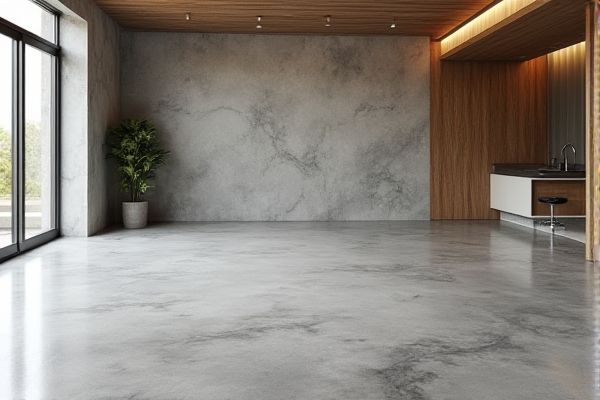
Epoxy floors offer a durable, glossy finish with a wide range of colors and customization options, while polished concrete provides a natural, low-maintenance surface with a sleek, reflective look. Explore the rest of the article to learn which flooring option best suits Your space and lifestyle needs.
Table of Comparison
| Feature | Epoxy Floor | Polished Concrete |
|---|---|---|
| Material | Epoxy resin coating | Polished and densified concrete surface |
| Durability | High, resists chemicals and abrasion | Very high, withstands heavy traffic and impact |
| Maintenance | Requires reapplication over time; easy cleaning | Low-maintenance, occasional resealing |
| Appearance | Glossy, customizable colors and patterns | Natural stone-like finish, reflective surface |
| Installation Time | 1-3 days including curing | 2-4 days depending on concrete prep |
| Cost | Moderate to high per square foot | Moderate, cost-effective over time |
| Slip Resistance | Can be slippery unless additives are used | Better natural slip resistance |
| Lifespan | 5-10 years with proper maintenance | 15+ years durable |
| Environmental Impact | Contains chemicals; less eco-friendly | Eco-friendly, uses existing concrete structure |
Introduction to Epoxy Floors and Polished Concrete
Epoxy floors consist of a durable resin coating that enhances surface strength and resistance to chemicals, ideal for garages and industrial spaces. Polished concrete involves mechanically grinding and polishing the concrete slab to achieve a smooth, reflective finish that is both low-maintenance and long-lasting. Your choice depends on aesthetic preference and functional needs, as epoxy offers customizable color options while polished concrete highlights natural aggregate patterns.
What is Epoxy Flooring?
Epoxy flooring is a durable, resin-based coating applied to concrete floors, providing a glossy, seamless surface resistant to chemicals, stains, and heavy traffic. Unlike polished concrete, which relies on grinding and polishing the existing slab, epoxy flooring creates a protective layer that can be customized with various colors and textures to enhance aesthetic appeal. You can choose epoxy flooring for its superior resistance and design versatility in industrial, commercial, and residential spaces.
What is Polished Concrete Flooring?
Polished concrete flooring is a durable surface created by mechanically grinding and honing a concrete slab to achieve a smooth, glossy finish that enhances the floor's strength and appearance. This process involves multiple levels of grinding with diamond tools followed by the application of chemical densifiers to harden the concrete and increase its resistance to stains and wear. Polished concrete is low-maintenance, environmentally friendly, and can be customized with various levels of sheen and color additives to match aesthetic and functional requirements.
Durability Comparison: Epoxy vs. Polished Concrete
Epoxy floors offer superior resistance to chemicals, stains, and abrasion, making them ideal for high-traffic commercial areas, while polished concrete provides excellent durability with a natural hardness that withstands heavy impact and wear over time. Epoxy coatings form a protective layer that can chip or peel if not properly maintained, whereas polished concrete penetrates and hardens the surface, reducing maintenance needs and enhancing longevity. Your choice depends on the environment's exposure to chemicals and the preferred balance between maintenance and performance.
Installation Process: Epoxy vs. Polished Concrete
Epoxy flooring installation involves surface cleaning, priming, and multiple layers of resin applied with rollers or squeegees, typically curing within 24-72 hours, making it faster to complete compared to polished concrete. Polished concrete requires grinding the concrete surface progressively with diamond abrasives, densifying, and multiple polishing steps to achieve a smooth, glossy finish, which can take several days to weeks depending on floor size and condition. Your choice impacts downtime and project timelines, with epoxy offering quicker installation but polished concrete providing a durable, low-maintenance finish.
Maintenance and Cleaning Requirements
Epoxy floors require regular sweeping and occasional mopping with a mild detergent to maintain their glossy finish and prevent surface scratches. Polished concrete demands less frequent cleaning, often needing only dust mopping and neutral pH cleaners to preserve its shine and prevent dulling. Both surfaces benefit from prompt spill cleanup to avoid staining, but epoxy is more susceptible to damage from harsh chemicals compared to polished concrete.
Cost Analysis: Epoxy vs. Polished Concrete
Epoxy flooring typically costs between $3 to $12 per square foot, making it more affordable for smaller projects but potentially higher for extensive setups requiring multiple layers and surface prep. Polished concrete ranges from $4 to $15 per square foot, with costs influenced by slab condition, grind level, and desired gloss, often presenting long-term savings due to its durability and low maintenance. Considering lifecycle expenses, polished concrete generally offers better return on investment despite higher initial costs, while epoxy suits budget-conscious applications with moderate wear requirements.
Aesthetics and Design Options
Epoxy floors offer vibrant colors, customizable patterns, and a glossy finish that enhances any space with high aesthetic appeal and creative design flexibility. Polished concrete features a natural, sleek look with subtle variations in tone and texture, providing a modern and minimalist style ideal for industrial or contemporary interiors. Your choice between epoxy and polished concrete depends on whether you prefer bold design options or understated elegance in flooring.
Ideal Applications and Suitability
Epoxy floors excel in industrial and commercial settings requiring chemical resistance, durability, and easy maintenance, making them ideal for warehouses, garages, and healthcare facilities. Polished concrete suits high-traffic areas like retail stores, offices, and showrooms due to its natural aesthetic, slip resistance, and long-lasting performance. Your choice depends on whether you prioritize vibrant customization and chemical protection (epoxy) or durability with a sleek, low-maintenance finish (polished concrete).
Which Flooring is Best for Your Needs?
Epoxy floors provide a durable, chemical-resistant surface ideal for garages and industrial spaces, while polished concrete offers a sleek, low-maintenance option perfect for commercial and residential settings. Consider your environment's traffic levels, exposure to chemicals, and aesthetic preferences when deciding which flooring suits your needs best. Your choice depends on balancing functionality with design to achieve the optimal flooring solution.
 homyna.com
homyna.com